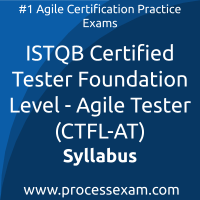 To achieve the professional designation of ISTQB Certified Tester Foundation Level - Agile Tester from the ISTQB, candidates must clear the CTFL-AT Exam with the minimum cut-off score. For those who wish to pass the ISTQB Agile Tester certification exam with good percentage, please take a look at the following reference document detailing what should be included in ISTQB CTFL-Agile Tester Exam preparation.
To achieve the professional designation of ISTQB Certified Tester Foundation Level - Agile Tester from the ISTQB, candidates must clear the CTFL-AT Exam with the minimum cut-off score. For those who wish to pass the ISTQB Agile Tester certification exam with good percentage, please take a look at the following reference document detailing what should be included in ISTQB CTFL-Agile Tester Exam preparation.
The ISTQB CTFL-AT Exam Summary, Sample Question Bank and Practice Exam provide the basis for the real ISTQB Certified Tester Foundation Level - Agile Tester (CTFL-AT) exam. We have designed these resources to help you get ready to take ISTQB Certified Tester Foundation Level - Agile Tester (CTFL-AT) exam. If you have made the decision to become a certified professional, we suggest you take authorized training and prepare with our online premium ISTQB Agile Tester Practice Exam to achieve the best result.
ISTQB CTFL-AT Exam Summary:
| Exam Name | ISTQB Certified Tester Foundation Level - Agile Tester |
| Exam Code | CTFL-AT |
| Exam Fee | USD $200 |
| Exam Duration | 60 Minutes |
| Number of Questions | 40 |
| Passing Score | 26/40 |
| Format | Multiple Choice Questions |
| Schedule Exam | Pearson VUE |
| Sample Questions | ISTQB CTFL-Agile Tester Exam Sample Questions and Answers |
| Practice Exam | ISTQB Certified Tester Foundation Level - Agile Tester (CTFL-AT) Practice Test |
ISTQB Agile Tester Syllabus Topics:
| Topic | Details |
|---|---|
Agile Software Development - 150 mins. |
|
| The Fundamentals of Agile Software Development |
- Recall the basic concept of Agile software development based on the Agile Manifesto - Understand the advantages of the whole-team approach - Understand the benefits of early and frequent feedback |
| Aspects of Agile Approaches |
- Recall Agile software development approaches - Write testable user stories in collaboration with developers and business representatives - Understand how retrospectives can be used as a mechanism for process improvement in Agile projects - Understand the use and purpose of continuous integration - Know the differences between iteration and release planning, and how a tester adds value in each of these activities |
Fundamental Agile Testing Principles, Practices, and Processes - 105 mins. |
|
| The Differences between Testing in Traditional and Agile Approaches |
- Describe the differences between testing activities in Agile projects and non-Agile projects - Describe how development and testing activities are integrated in Agile projects - Describe the role of independent testing in Agile projects |
| Status of Testing in Agile Projects |
- Describe the tools and techniques used to communicate the status of testing in an Agile project, including test progress and product quality - Describe the process of evolving tests across multiple iterations and explain why test automation is important to manage regression risk in Agile projects |
| Role and Skills of a Tester in an Agile Team |
- Understand the skills (people, domain, and testing) of a tester in an Agile team - Understand the role of a tester within an Agile team |
Agile Testing Methods, Techniques, and Tools - 480 mins. |
|
| Agile Testing Methods |
- Recall the concepts of test-driven development, acceptance test-driven development, and behavior-driven development - Recall the concepts of the test pyramid - Summarize the testing quadrants and their relationships with testing levels and testing types - For a given Agile project, practice the role of a tester in a Scrum team |
| Assessing Quality Risks and Estimating Test Effort |
- Assess quality risks within an Agile project - Estimate testing effort based on iteration content and quality risks |
| Techniques in Agile Projects |
- Interpret relevant information to support testing activities - Explain to business stakeholders how to define testable acceptance criteria - Given a user story, write acceptance test-driven development test cases - For both functional and non-functional behavior, write test cases using black box test design techniques based on given user stories - Perform exploratory testing to support the testing of an Agile project |
| Tools in Agile Projects | - Recall different tools available to testers according to their purpose and to activities in Agile projects |
Both ISTQB and veterans who’ve earned multiple certifications maintain that the best preparation for a ISTQB CTFL-AT professional certification exam is practical experience, hands-on training and practice exam. This is the most effective way to gain in-depth understanding of ISTQB CTFL-Agile Tester concepts. When you understand techniques, it helps you retain ISTQB Agile Tester knowledge and recall that when needed.
